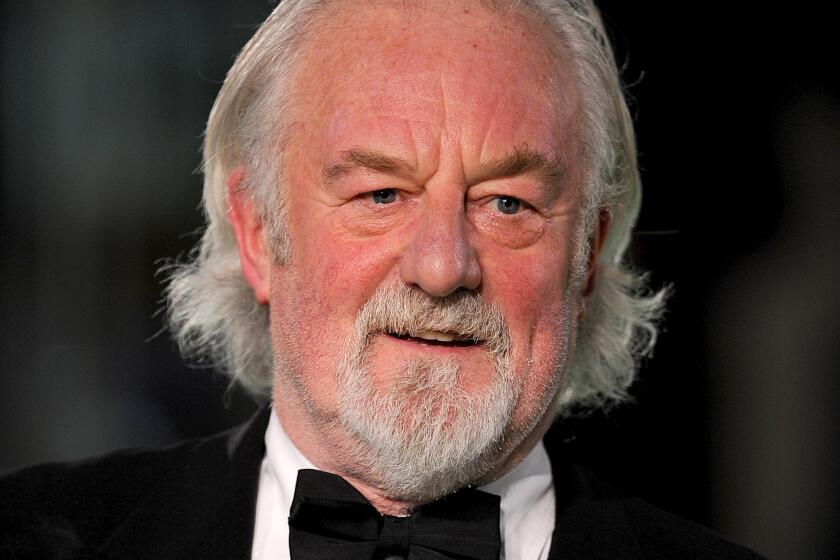COLUMN ONE : A Push for PG-Rated Playthings : Some companies are starting to soften the violence in toyland. Such self-policing only goes so far, though, because gore sells big--especially with hot summer movie tie-ins.
In the film “Last Action Hero,” houses explode, cars crash and dead bodies turn up in swimming pools and parking garages, on roof tops--even in a tar pit.
This is the stuff that toys are made of. But children seeking to re-create movieland-style mayhem with the “Last Action Hero” toy line are in for a surprise. The eight-inch plastic figures of star Arnold Schwarzenegger come with ropes, axes, hooks and dynamite--but no guns.
The toy, marketed to children considered too young to see Columbia’s PG-13 movie, also comes with this message printed on the box: “In real life, guns and violence are a big mistake . . . never play with real guns.”
Mattel’s somewhat kinder, gentler super-hero signals a change in the way make-believe violence is being marketed to children, a potentially groundbreaking shift that is emerging at some companies this summer.
For years, the industry has resisted pressure to limit violence because shoot-’em-up toys are very successful. However, increased concern about violent entertainment--leading to this week’s historic agreement by TV networks to issue viewer warnings--is causing at least a few toy companies to act.
Sega of America has announced plans to rate its video games the way Hollywood rates movies, to help parents make suitable choices for children. Electronic Arts, a leading maker of video and computer games, said this week that it also is considering a ratings system.
The move by manufacturers to curb violence in toys is not widespread, and some prominent companies, like Hasbro--the maker of G.I. Joe--argue there is no need for reforms. (Unlike the television industry, the toy business does not face congressional regulation.)
Several events in the past year have nonetheless created pressure for change:
* Toys R Us in Canada has refused to sell “Night Trap,” a Sega game that depicts bloody attacks on young women.
* In Britain, the same game came under attack on the floor of Parliament. Sega says it will work with the government to develop a rating for “Night Trap.”
* In Hawaii, state lawmakers narrowly defeated legislation that would have required retailers to post warnings that so-called “war toys”--action figures, video games and even water pistols--”increase anger and violence in children.”
“The toy industry doesn’t lead, it follows,” said Carolyn Shapiro, editor of the trade magazine, Toy & Hobby World. “If things change outside the industry, it responds. . . . This may be the start of a trend.”
Controversy about violent toys probably has been around since kids picked up slingshots. In the past 30 years, researchers have observed children’s play with war toys and their subsequent behavior. Studies have demonstrated that children exhibit aggression after playing with guns and action figures.
For more than a decade, pacifist organizations have rallied to no avail against such toy tough guys as Rambo, an action figure based on the movie. Its maker, now-defunct Coleco Industries, did not drop Rambo until kids dropped it for the next super-hero.
In the ‘90s, a stream of carjackings, drive-by shootings and other crimes involving teen-agers have fueled the perception that violence is out of control. “As a society, we’re reaching our limit for violence,” said Dr. Carole Lieberman, a UCLA psychiatrist, who has testified before Congress on the issue. “There is a growing perception that violent entertainment is not OK.”
There is intense disagreement in the industry over where to draw the line when it comes to violent toys. Video game firms are sharply divided over how to use an advanced technology that brings film-quality realism to deadly duels. Toy companies appear split over how to transform the themes of violent films into acceptable products for young children.
A look at the toys linked to this summer’s action films highlights the differences: A Hasbro unit is selling a line of toys based on Universal’s scary, blockbuster film “Jurassic Park” complete with wounded dinosaurs and people. On the other hand, Mattel not only took away the guns from its “Last Action Hero” line, but labeled the toys “stunt” instead of “action” figures.
The confusion reflects America’s paradoxical relationship with violent entertainment. In a February poll conducted by the Times Mirror Center on People and the Press, a majority of Americans denounced violent TV while admitting that they spend a lot of time watching it.
The situation with violent toys is just as muddled. Much-maligned “war toys” are big sellers. Helped along by lines based on “Terminator 2” and “Batman Returns”--both violent films--action figure sales rose last year to nearly $500 million. They were snapped up mostly by children ages 4 to 9.
Sales expectations are high for the “Jurassic Park” action figures. Prospects for “Last Action Hero” toys are less certain because the movie is doing poorly. In fact, a trade magazine on Thursday said Mattel had stopped production of the toy line, but company officials denied the report.
Make-believe violence also sells when it comes to video games, which brought in $4 billion last year, a 50% increase. The best-seller was “Street Fighter II,” a fast-paced martial arts game, which rang up a record $160 million for Nintendo of America. About two-thirds of video game sales are to children under 15.
Marketing experts say children, especially boys under 9, seek out violent toys because they give them a sense of control and power lacking in their lives. “It all comes down to physical dominance. . . . When you put a gun in a character’s hand, it has all the more power,” said Dan Acuff, president of Youth Marketing Systems, a Glendale consulting firm.
Acuff said parents buy the toys because “their children are begging for them. Parents know their children will play with them, and keep occupied.”
No company is proposing to take violence out of play. The video game companies are discussing a system that would alert buyers about violence, but not eliminate it. Schwarzenegger’s plastic alter-ego cannot shoot its enemies, but it can blow them up with dynamite; the toy comes with directions on how to hurl it. Mattel has been reluctant to say whether it will incorporate anti-gun messages with subsequent action figures.
Skeptics wonder whether toy makers are struck with an attack of conscience or “political correctness.” Lieberman, the UCLA psychiatrist, called rating systems and anti-gun warnings “public relations ploys.”
However, Roy Takumi, the Hawaiian legislator who sponsored the failed toy labeling law, sees the changes in the industry as an important first step.
“I think toy companies are beginning to get the message,” he said. “I don’t want to see these toys banned. But I think consumers should be warned about the violence in toys.”
The first test of Sega’s rating system will come this fall, when the arcade game “Mortal Kombat” arrives on cartridges for the Nintendo and Sega home systems.
“Mortal Kombat” owes its popularity to “fatality moves,” skillful maneuvers that allow players to finish opponents with bloody blows. Take it from 11-year-old Damien Vansen, a regular at Family Arcade near Los Angeles City College:
“You can do fatality moves and actually watch the characters die. In other games, you can’t see that as well.”
Sega intends to include the popular moves in its version of the game, to be rated MA-13, the equivalent of PG-13, meaning it is suitable for teen-agers and adults. Nintendo plans to eliminate the moves from its game because its corporate standards do not permit blood or explicit violence.
The irony is that Nintendo expects to lose $6 million in potential sales because its game lacks the fatality moves. Sega has said it does not believe its rating system will hurt sales.
“If Sega really wants to limit violence, there is an answer: Don’t sell the game,” said Perin Kaplan, a Nintendo spokeswoman.
For all the concern and studies of their potential effect, it isn’t known whether violent toys and video games cause any harm.
UCLA psychiatrist Lieberman contends that violent toys pick up where violent TV shows or films leave off, numbing children to the horror of real violence. “The effect is cumulative,” she said.
Jeffery Derevensky, a child psychologist at Montreal’s McGill University, contends that violent toys are harmless if played with in moderation. The biggest concern about “war toys” is that they might interest children in seeing movies that are too scary or violent.
In the case of “Last Action Hero,” representatives of Mattel and Schwarzenegger argue that the toy softens the impact of the film, which depicts 57 death scenes, about one every two minutes. Schwarzenegger’s publicist said it was assumed that children would see the movie because the star is so popular with the grade-school set.
“Arnold realizes the children will see the film. That is why he insisted that no weapons be included with the toy. Particularly a toy that bears his image,” said Schwarzenegger publicist Charlotte Parker. She described the dynamite as “survival equipment.”
The companies involved with “Jurassic Park” have gone to extraordinary lengths to discourage young children from attending the scary PG-13 film, despite the curiosity-raising parade of dinosaurs, trading cards, action figures, sticker books and video games.
The film’s director, Steven Spielberg, said he considered the movie too scary for his four children, all under 9. Universal representatives advised parents to take the film’s rating seriously. They surveyed theater crowds and found that few young children were attending. Representatives of MCA-Universal and Kenner Products, manufacturer of the action figures, declined comment.
Despite such caveats, do all the kid-friendly promotions end up confusing parents?
It’s lunchtime at the McDonald’s in Temple City and the chain’s “Jurassic Park” promotion is in full swing. Parents and toddlers entering the restaurant are greeted by a kid-size cardboard cutout of a toothy Tyrannosaurus rex. Above the counter, “dino-fry” containers--there’s that T. Rex again--are displayed. Out at the McPlayground, preschoolers cling to mothers who cling to plastic souvenir cups depicting T. Rex , this time snarling at an overturned car.
Robin Giammuta of Upland explains that she is collecting the cups for her sons, ages 2 and 4. “They just love dinosaurs, from Barney”--the star of the PBS kids’ show--”to Jurassic Park,” she said. “I haven’t decided whether to take them (to the movie) yet.”
She is surprised to learn the film is rated PG-13: “Look at all the stuff for kids.”
More to Read
The biggest entertainment stories
Get our big stories about Hollywood, film, television, music, arts, culture and more right in your inbox as soon as they publish.
You may occasionally receive promotional content from the Los Angeles Times.






